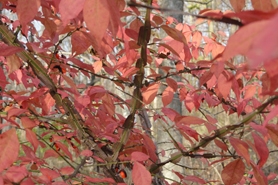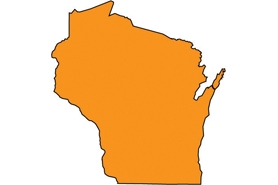Burning bush or winged euonymus
(Euonymus alatus)
Ornamental deciduous shrub with winged stems and branches, turning vibrant red in the fall.
Other names for this plant include:
- Common names: burning tree, winged burning bush, burning euonymus, winged wahoo, winged spindle-tree
- Scientific names: Euonymus striata, Celastrus alata, Celastrus striata
Classification in Wisconsin: Restricted (including the Nordine c'ltivar and excluding all other cultivars). Straight species and the cultivar 'Nordine' 're restricted. All different cultivars are exempt.
- Ecological Threat
-
- Invades forests, open woods, forest edges, pastures, prairies, and roadsides. Dominates hardwood forests shrub layer.
- It is reported as invasive throughout the northeast and midwest.
- Tolerates both full sun and full shade.
- Adaptable to a variety of soil conditions, with high salt tolerance.
- Prolific seed producer with high viability.
- Not palatable to white-tailed deer, resulting in more significant browse damage to native herbaceous plants and other desirable species.
- Identification
-
Leaves & stems: Shrubs have wings or distinct corky ridges on the bark and contains. On younger growth, this may be reduced. Leaves are arranged with opposite branches. Leaves are simple, elliptic with finely serrated edges. Foliage turns vibrant red colors in fall.
Flowers: Perfect (possessing male and female parts), inconspicuous, yellow-greenish flowers.
Fruits & seeds: Flay fruit capsules contain up to 4 seeds with red-orange fleshy tissue (arils).
Roots: Deeply rooted and fibrous.
Similar species: Wahoo (E. atropurpureus; native) can be distinguished from a burning bush by its larger growth form and Wahoo does not have the winged stems like a burning bush. Also, its autumn leaf color is yellow.
- Control
- Mechanical:
- Hand-pull seedlings. Use a spading fork or weed wrench to remove larger plants and their root systems.
- Larger plants can be cut, but the stump must be ground out or regrowth frequently monitored and clipped.
- This species can re-sprout after cutting and top-kill herbicides.
- Cut stumps can be painted with herbicide.
- If populations are too large for cutting to be practical, a foliar glyphosate spray can be applied in the early summer months.
- Note that this species can re-sprout after cutting and top-kill herbicides.
- Resources
- Sources for content:
- Fryer, Janet L. 2009. Euonymus alatus. In: Fire Effects Information System, [Online]. U.S. Department of Agriculture, Forest Service, Rocky Mountain Research Station, Fire Sciences Laboratory (Producer). Available: http://www.fs.fed.us/database/feis/ [2013, August 19].
- Czarapata, Elizabeth; Invasive Plants of the Upper Midwest: an illustrated guide to their identification and control. The University of Wisconsin Press. 2005. Pg. 90-91.
- Wisconsin State Herbarium.



